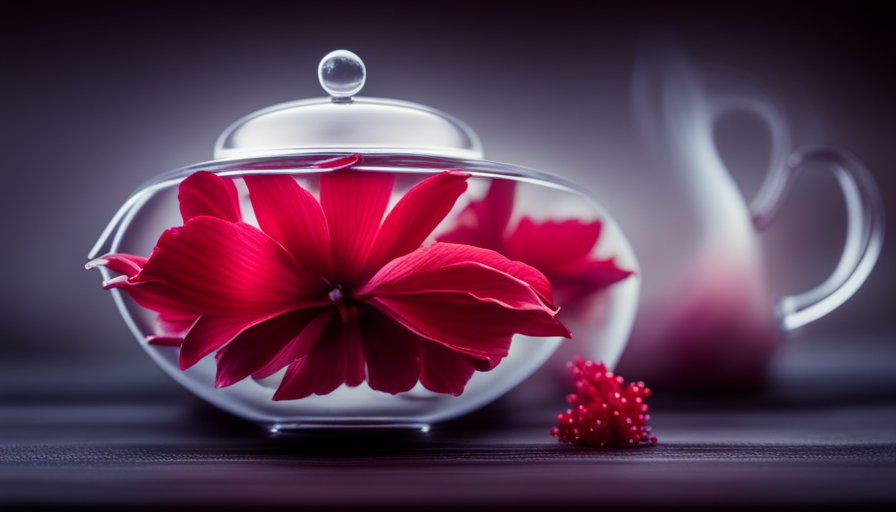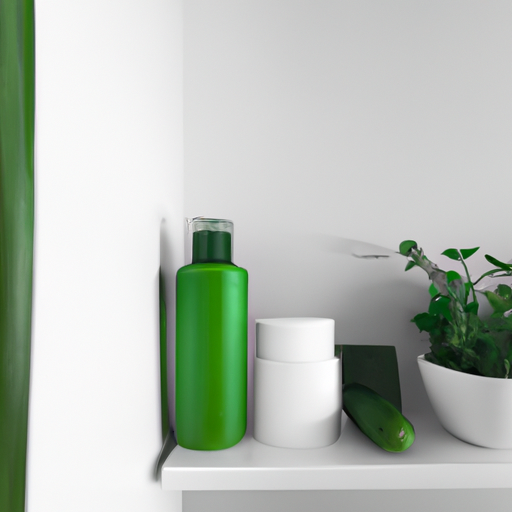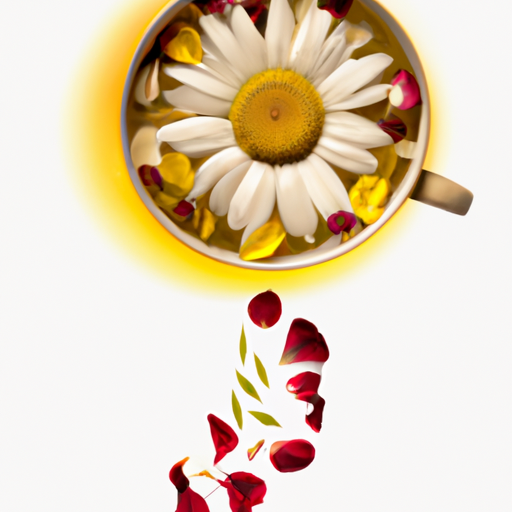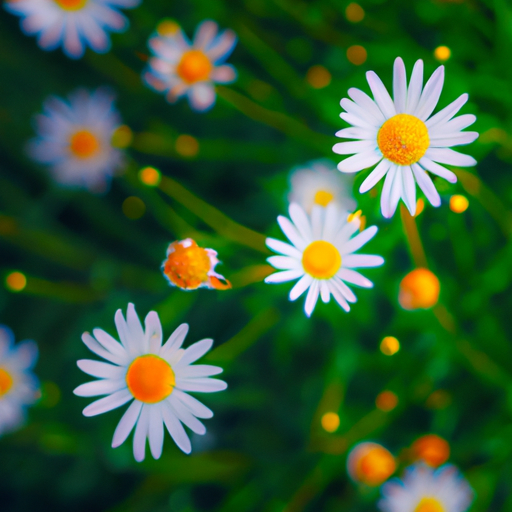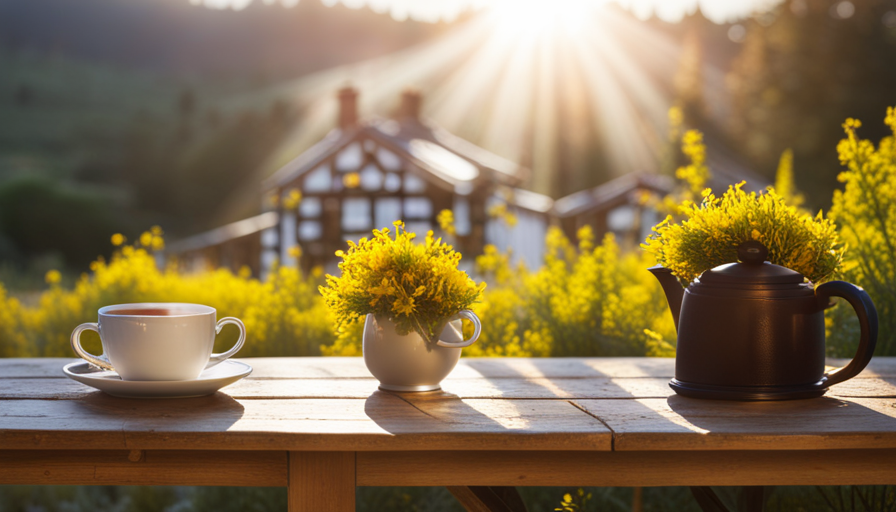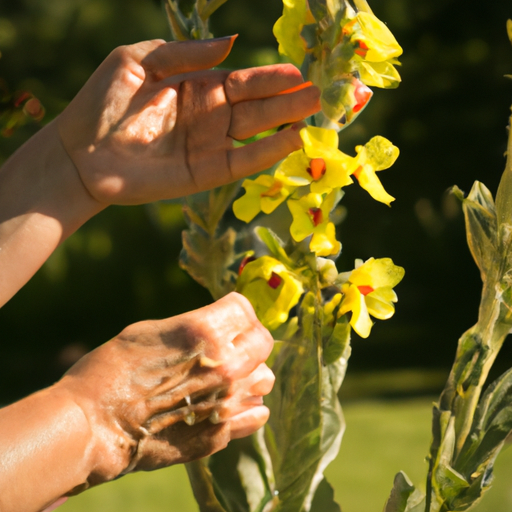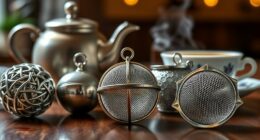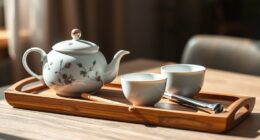Enter a world full of bold flavors and comforting scents as we set out on a quest to brew a delicious cup of tea using fresh hibiscus flowers. Similar to a beautiful melody of nature’s best elements, this special drink provides a perfect combination of flavor and health benefits.
Join me as I guide you through the art of crafting a cup of tea that will invigorate your senses and nourish your body.
With each sip, you will experience the exquisite essence of hibiscus, a flower renowned for its breathtaking beauty and remarkable health benefits. From selecting the perfect petals to infusing them with boiling water, we will unlock the secrets of extracting the full flavor profile of these delicate blossoms.
Along the way, we will explore the art of enhancing this tea with sweeteners and flavors, adjusting its strength to suit personal preferences, and even pairing it with delectable treats.
So, whether you seek a moment of tranquility or a burst of rejuvenation, let us embark on this enchanting journey together and discover the wonders of hibiscus tea.
Key Takeaways
- Hibiscus tea offers vibrant flavors and soothing aromas.
- It provides a harmonious blend of taste and wellness.
- The process of making tea with fresh hibiscus flowers involves selecting and preparing the flowers, brewing the tea using boiling water and steeping, and adding sweeteners and flavor enhancers.
- Hibiscus tea has numerous health benefits, including antioxidants, heart health, blood pressure regulation, and improved digestion.
Selecting and Preparing the Fresh Hibiscus Flowers
Before you begin brewing your tea, it’s crucial to carefully select and prepare the freshest hibiscus flowers for the most vibrant and flavorful infusion.
Preparing hibiscus tea starts with selecting flowers that are bright in color and free from any signs of wilting or browning. Look for petals that are plump and intact, as they indicate freshness. Once you have chosen your flowers, gently rinse them under cool water to remove any dirt or debris.
To brew the hibiscus flowers, you’ll need one cup of fresh petals for every two cups of water. Place the petals in a teapot or heatproof container.
Next, bring water to a boil in a kettle or saucepan. Once the water reaches a rolling boil, carefully pour it over the petals, ensuring they are fully submerged. Allow the flowers to steep for about 10 minutes to extract their vibrant flavors.
As the flowers steep, their deep red color will infuse into the water, creating a visually stunning brew. The longer you steep the flowers, the stronger the flavor will become.
Once the steeping time is complete, strain the liquid to remove the petals, leaving you with a rich and aromatic hibiscus tea.
Now, let’s move on to the next section about boiling water and steeping the flowers to enhance the tea’s taste even further.
Boiling Water and Steeping the Flowers
Once the water’s reached a rolling boil, let it steep with the hibiscus flowers for at least 10 minutes to release their vibrant flavors and rich antioxidants. This step’s crucial in infusing flavors into the tea, as the hot water helps extract the essence of the hibiscus petals.
During this time, the water’ll turn a deep red color, indicating that the flavors are being released.
To enhance the taste of your hibiscus tea, you can experiment with alternative brewing methods. One option’s to use a French press, which allows for a more intense flavor extraction. Simply add the hibiscus flowers to the press, pour in the boiling water, and let it steep for the desired amount of time.
Another option’s cold brewing, where you soak the flowers in cold water overnight. This method results in a smoother, less tart flavor profile.
After steeping, strain the tea to remove the hibiscus flowers, and it’s now ready to be enjoyed.
In the next section, we’ll explore adding sweeteners and flavor enhancers to further enhance the taste and aroma of your hibiscus tea.
Adding Sweeteners and Flavor Enhancers
To elevate your hibiscus tea experience, why not add a touch of sweetness or a burst of flavor enhancements? There are several sweetener alternatives that can complement the tartness of hibiscus flowers.
One option is to use honey, which adds a natural sweetness and a hint of floral notes. Another alternative is agave syrup, which has a milder flavor and blends well with the tangy taste of hibiscus. If you prefer a less conventional sweetener, you can try stevia, a natural, calorie-free option that won’t overpower the delicate flavors of the tea.
In addition to sweeteners, there are various natural flavorings you can experiment with to enhance your hibiscus tea. Freshly squeezed lemon or lime juice can add a refreshing citrus twist, balancing out the tartness. You can also try adding a few sprigs of mint for a cool, herbal taste. For a more exotic flavor, consider infusing the tea with a slice of ginger or a sprinkle of cinnamon.
By incorporating these sweetener alternatives and natural flavorings, you can create a personalized and delightful hibiscus tea experience.
Now, let’s move on to adjusting the strength and concentration of the tea to suit your taste preferences.
Adjusting the Strength and Concentration of the Tea
If you’re looking to intensify or mellow out the flavors in your hibiscus infusion, there’s a simple trick you can try. Adjusting the strength and concentration of the tea can make a big difference in the final taste. Here are three ways you can achieve this:
-
Adjust brewing time: The longer you steep the hibiscus flowers, the stronger the tea will become. If you prefer a more robust flavor, let it steep for a longer period of time. On the other hand, if you want a lighter taste, reduce the brewing time. It’s all about finding the perfect balance that suits your palate.
-
Use different tea infusers: The type of tea infuser you use can also impact the strength of your hibiscus tea. If you want a stronger brew, opt for a fine mesh infuser. This allows more of the flavors to infuse into the water. Alternatively, if you prefer a milder taste, try using a larger infuser that gives the flowers more room to expand.
-
Experiment with the ratio of flowers to water: Finding the right ratio of hibiscus flowers to water can help you achieve the desired strength. If you want a stronger tea, increase the amount of flowers. For a milder taste, reduce the quantity. It may take a bit of trial and error to find the perfect balance, but it’s worth it for the best flavor.
By adjusting the strength and concentration of your hibiscus tea, you can create a brew that perfectly suits your taste buds.
Now, let’s move on to the next step of straining and serving the tea.
Straining and Serving the Tea
When it’s time to enjoy your vibrant hibiscus infusion, strain the liquid through a sieve like a gentle rain shower, allowing the flavors to cascade into your cup. This step is crucial to ensure a smooth and enjoyable tea experience. By straining the tea, you remove any remaining flower petals or other plant material, resulting in a clean and clear beverage. The sieve acts as a filter, catching any unwanted particles and preventing them from reaching your cup.
Once you’ve strained the tea, it’s ready to be served. You can enjoy it hot or cold, depending on your preference. If you prefer a cold beverage, you can add ice cubes or refrigerate the tea for a refreshing summer drink. For a hot cup of tea, simply pour the strained liquid into a mug or teacup and savor the rich flavors.
Apart from being a delicious beverage, hibiscus tea offers numerous health benefits. It’s known to be rich in antioxidants, which help protect the body against free radicals and promote overall wellness. Additionally, hibiscus tea is believed to support heart health, lower blood pressure, and aid in digestion.
As you become more familiar with making hibiscus tea, don’t be afraid to experiment with different variations and combinations. In the next section, we’ll explore how to customize your tea by adding other ingredients and flavors to create a unique and personalized beverage.
Experimenting with Different Variations and Combinations
After straining and serving the tea, it’s time to get creative and have some fun experimenting with different variations and combinations of hibiscus tea.
There are countless ways to customize your tea to suit your taste and preferences.
First, let’s talk about different brewing techniques. You can try steeping the hibiscus flowers in hot water for a shorter or longer period of time to adjust the strength of the tea. For a stronger flavor, you can also try boiling the flowers instead of steeping them. Additionally, you can mix hibiscus with other types of tea like green tea or black tea to create unique flavor profiles.
Now, let’s move on to exploring unique flavor combinations. You can add a splash of citrus juice like lemon or orange to give the tea a tangy twist. If you prefer a sweeter taste, you can sweeten the tea with honey, agave syrup, or even a dash of cinnamon. For a refreshing summer drink, you can add some fresh mint leaves or cucumber slices to your tea.
By experimenting with different brewing techniques and unique flavor combinations, you can truly make hibiscus tea your own.
In the next section, we’ll delve into the health benefits of hibiscus tea and how it can boost your well-being.
Exploring the Health Benefits of Hibiscus Tea
Discover the numerous ways hibiscus tea can enhance your well-being and improve your health. Exploring scientific research has shown that hibiscus tea offers a range of health benefits. It is rich in antioxidants, which help protect against cell damage and reduce the risk of chronic diseases such as heart disease and cancer. Additionally, hibiscus tea has been found to lower blood pressure, reduce cholesterol levels, and improve liver health.
Traditionally, hibiscus tea has been used in various cultures for its medicinal properties. In many countries, it is consumed to alleviate high blood pressure and promote kidney health. Some cultures also believe that hibiscus tea can aid in weight loss and digestion. Moreover, the vibrant red color of hibiscus tea holds cultural significance in many ceremonies and celebrations.
To better visualize the health benefits of hibiscus tea, refer to the table below:
| Health Benefit | Description |
|---|---|
| Antioxidant | Protects against cell damage |
| Blood Pressure | Lowers high blood pressure |
| Cholesterol Levels | Reduces cholesterol levels |
| Liver Health | Improves liver function |
With an understanding of the scientific research and cultural significance behind hibiscus tea, let’s now move on to exploring how to store and preserve fresh hibiscus flowers.
Storing and Preserving Fresh Hibiscus Flowers
To keep the vibrant essence of hibiscus flowers alive, just like a sealed time capsule, proper storage is key. Preserving fresh hibiscus flowers can be done using different techniques, but one of the most popular methods is drying them. Dried hibiscus flowers not only retain their beautiful color, but also their flavor and health benefits.
To start, gently pluck the fresh hibiscus flowers from the plant, making sure to remove any dirt or insects. Rinse them under cold water and pat them dry with a clean towel. Next, spread the flowers out on a baking sheet or a wire rack, ensuring that they aren’t touching each other. Place the baking sheet in a well-ventilated area, away from direct sunlight, and let the flowers dry naturally for about 2-3 weeks.
Once the flowers are completely dry, store them in an airtight container, preferably made of glass, to protect them from moisture and air. Keep the container in a cool, dark place, such as a pantry or a cupboard. Properly stored, dried hibiscus flowers can last for up to a year without losing their flavor or potency.
By using these preserving techniques, you can enjoy hibiscus tea all year round, even when fresh flowers aren’t readily available.
Now, let’s explore the exciting world of pairing hibiscus tea with food and desserts.
Pairing Hibiscus Tea with Food and Desserts
Enhance your culinary experience by exploring the delightful combinations of hibiscus tea with a variety of delectable dishes and desserts. Not only does hibiscus tea offer a refreshing and vibrant flavor, but it also pairs wonderfully with cocktails. Add a splash of hibiscus tea to your favorite mixed drink for a unique twist that’ll impress your guests.
The floral and tangy notes of the tea complement the flavors of various spirits, creating a harmonious and refreshing beverage.
But hibiscus tea isn’t just for beverages; it can also be incorporated into savory dishes. The tart and slightly citrusy taste of hibiscus tea adds a delightful complexity to marinades, dressings, and sauces. Try infusing hibiscus tea into your next barbecue sauce or using it as a base for a tangy vinaigrette. The possibilities are endless when it comes to using hibiscus tea in your savory creations.
Now that you know how to pair hibiscus tea with cocktails and incorporate it into savory dishes, it’s time to share and enjoy this delightful beverage with your friends and family. Whether you’re hosting a dinner party or simply enjoying a cup of hibiscus tea with loved ones, the vibrant flavors and beautiful color of this tea are sure to impress.
So gather your loved ones, brew a pot of hibiscus tea, and savor the moment together.
Sharing and Enjoying the Tea with Friends and Family
Invite your loved ones over and create unforgettable memories while indulging in the delightful experience of sharing and savoring the vibrant flavors of this exquisite beverage. When it comes to enjoying hibiscus tea with friends and family, there are a few key elements that can enhance the experience.
Here are some tips to make your tea party a success:
-
Finding unique hibiscus tea recipes: Experiment with different flavors by adding ingredients like orange peel, ginger, or mint to your hibiscus tea. This won’t only add a refreshing twist to the traditional taste but also allow you to discover new and exciting combinations.
-
Creating a relaxing tea party ambiance: Set the mood by decorating the space with soft lighting, comfortable seating, and soothing music. Consider using floral arrangements or hibiscus-themed tableware to add an elegant touch. Encourage your guests to unwind and enjoy the moment by providing cozy blankets or cushions.
-
Serving hibiscus-infused treats: Complement the tea with delectable treats such as hibiscus-infused macarons, cupcakes, or fruit tarts. These delightful treats won’t only please the taste buds but also add a visually appealing element to the table.
By following these tips, you can create a truly memorable tea party experience for your loved ones. So, gather your friends and family, and let the enchanting flavors of hibiscus tea transport you to a world of relaxation and indulgence.
Frequently Asked Questions
How do I know if the hibiscus flowers I have selected are fresh and of good quality?
Ah, the eternal dilemma of selecting high-quality hibiscus flowers. Fear not, for I’m here to enlighten you on this crucial matter.
To determine freshness, inspect the petals, ensuring they’re vibrant and free from blemishes or discoloration. A gentle squeeze should reveal a slight firmness, indicating optimal freshness.
Additionally, opt for flowers that have a strong, sweet fragrance, as this is a telltale sign of quality.
Now, armed with this knowledge, you’ll conquer the realm of hibiscus flower selection!
Can I reuse the hibiscus flowers for a second infusion to make more tea?
Yes, you can definitely reuse the hibiscus flowers for a second infusion to make more tea. There are actually some benefits to doing so. When you reuse the flowers, you can extract even more of their flavor and nutrients. The second infusion may have a slightly milder taste, but it’ll still be delicious and refreshing. Just make sure to steep the flowers for a bit longer to get the most out of them.
Can I add milk or cream to my hibiscus tea?
Adding milk or cream to hibiscus tea can be a personal preference, but it may not be the best choice. The strong, tangy flavor of hibiscus might not pair well with the creamy taste of dairy. However, if you enjoy the combination, go ahead and try it! Just be aware that the milk or cream might mellow out the tartness of the tea.
If you prefer a dairy-free option, consider using almond milk or coconut milk for a lighter, plant-based alternative.
Can I use dried hibiscus flowers instead of fresh ones?
Yes, you can definitely use dried hibiscus flowers instead of fresh ones. Dried hibiscus flowers have several benefits, including a longer shelf life and concentrated flavor.
To properly dry hibiscus flowers, start by harvesting the flowers when they’re fully bloomed. Remove the petals and spread them out on a clean, dry surface. Allow them to dry completely in a well-ventilated area, away from direct sunlight. Once dried, store them in an airtight container for future use.
How long can I store fresh hibiscus flowers before they start to lose their flavor and potency?
Fresh hibiscus flowers have a shelf life of about 7-10 days before they start to lose their flavor and potency. To preserve their freshness, store them in a cool, dry place away from direct sunlight. You can also place them in an airtight container or wrap them in a damp paper towel to maintain their moisture. Remember to check for any signs of wilting or discoloration, and discard any flowers that have gone bad.
Conclusion
In conclusion, making tea with fresh hibiscus flowers is a delightful and invigorating experience. As you carefully select and prepare the flowers, their vibrant colors and delicate petals create a visual feast for the eyes.
The aroma of the boiling water mingling with the floral notes of the hibiscus is enough to transport you to a tropical paradise. Adding sweeteners and flavor enhancers allows you to tailor the tea to your taste preferences, while the health benefits of hibiscus tea provide a nourishing boost.
Straining and serving the tea is a satisfying ritual, and as you share it with loved ones, the joy and warmth it brings is truly unmatched.
So next time you spot fresh hibiscus flowers, seize the opportunity to create a cup of tea that’s as beautiful as it’s delicious.

